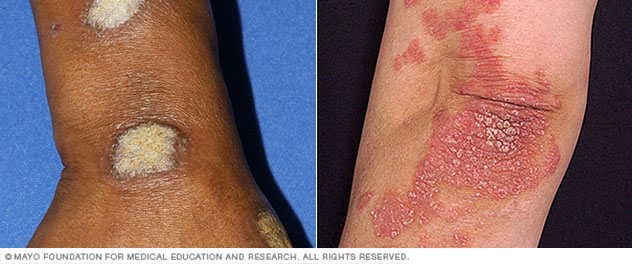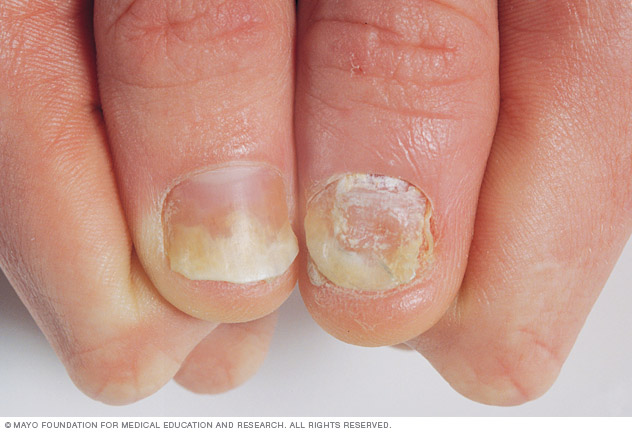Overview
Plaque psoriasis

Plaque psoriasis
Plaque psoriasis is the most common type of psoriasis. It usually causes dry, red skin lesions (plaques) covered with silvery scales.
Psoriatic arthritis is a form of arthritis that affects some people who have psoriasis — a disease that causes red patches of skin topped with silvery scales. Most people develop psoriasis years before being diagnosed with psoriatic arthritis. But for some, the joint problems begin before skin patches appear or at the same time.
Joint pain, stiffness and swelling are the main signs and symptoms of psoriatic arthritis. They can affect any part of the body, including your fingertips and spine, and can range from relatively mild to severe. In both psoriasis and psoriatic arthritis, disease flares can alternate with periods of remission.
There's no cure for psoriatic arthritis. Treatment is aimed at controlling symptoms and preventing joint damage. Without treatment, psoriatic arthritis can be disabling.
Products & Services
Symptoms
Both psoriatic arthritis and psoriasis are chronic diseases that worsen over time. However, you might have periods when your symptoms improve or go away temporarily.
Psoriatic arthritis can affect joints on one or both sides of your body. The signs and symptoms of psoriatic arthritis often resemble those of rheumatoid arthritis. Both diseases cause joints to become painful, swollen and warm to the touch.
However, psoriatic arthritis is more likely to also cause:
- Swollen fingers and toes. Psoriatic arthritis can cause a painful, sausage-like swelling of your fingers and toes.
- Foot pain. Psoriatic arthritis can also cause pain at the points where tendons and ligaments attach to your bones — especially at the back of your heel (Achilles tendinitis) or in the sole of your foot (plantar fasciitis).
- Lower back pain. Some people develop a condition called spondylitis as a result of psoriatic arthritis. Spondylitis mainly causes inflammation of the joints between the vertebrae of your spine and in the joints between your spine and pelvis (sacroiliitis).
- Nail changes. Nails can form tiny dents (pits), crumble or separate from the nail beds.
- Eye inflammation. Uveitis can cause eye pain, redness and blurry vision. If untreated, uveitis can lead to vision loss.
When to see a doctor
If you have psoriasis, tell your doctor if you develop joint pain. Psoriatic arthritis can severely damage your joints if left untreated.
Causes
Psoriatic arthritis occurs when your body's immune system attacks healthy cells and tissue. The immune response causes inflammation in your joints as well as overproduction of skin cells.
It seems likely that both genetic and environmental factors play a role in this immune system response. Many people with psoriatic arthritis have a family history of either psoriasis or psoriatic arthritis. Researchers have discovered certain genetic markers that appear to be associated with psoriatic arthritis.
Physical trauma or something in the environment — such as a viral or bacterial infection — might trigger psoriatic arthritis in people with an inherited tendency.
Risk factors
Psoriasis on the nails

Psoriasis on the nails
In some cases, psoriasis can cause pitted and deformed nails that are thickened and discolored. Nails may also separate from the nail bed.
Several factors can increase your risk of psoriatic arthritis, including:
- Psoriasis. Having psoriasis is the single greatest risk factor for developing psoriatic arthritis.
- Family history. Many people with psoriatic arthritis have a parent or a sibling with the disease.
- Age. Although anyone can develop psoriatic arthritis, it occurs most often in adults between the ages of 30 and 55.
Complications
A small percentage of people with psoriatic arthritis develop arthritis mutilans — a severe, painful and disabling form of psoriatic arthritis. Over time, arthritis mutilans destroys the small bones in the hands, especially the fingers, leading to permanent deformity and disability.
Psoriatic arthritis also puts some people at higher risk of developing hypertension, metabolic syndrome, diabetes and cardiovascular disease
Oct. 02, 2021